Pentacon Six Mount
Cameras
by TRA
The
Cameras
The Pentacon Six lens mount is found on
a remarkably wide range of cameras:
- The Praktisix, which is the
predecessor of the Pentacon Six (More
information on this camera here!)
- the Pentacon Six and Pentacon Six
TL (More information on these
cameras here!)
- In some countries these cameras
were marketed as “Hanimex Praktica” or “Hanimex
66” (More information on this camera here!)
- The Pentacon Six TLs (More
information on this camera here!)
- The Kiev 6C, which is the
predecessor of the Kiev 60 (More
information on this camera here!)
- The Kiev 60 (More
information on this camera here!)
- The Pentasix (More
information on this camera here!)
- The Arax 60 and Arax 645 (More
information on these cameras here!)
- The Kiev 90 (645 format) (More
information on this camera here!)
- The Exakta 66 Mk I – Mk III
manufactured between the 1980s and 2000+ (More
information on these cameras here!)
(Information on older, non-compatible
cameras called "Exakta 6×6" or "Exakta 66" here)
- various versions of the Kiev 88
fitted either by the manufacturer or other suppliers
with a variation of the Pentacon Six mount:
The "Kiev "B.i.G" from
Brenner (More
information on this camera here!)
The Kiev 88 CM (Brief
information here;
more information to be added in due course)
New in September 2021:
For information on camera format sizes, see here.
|
|
For information about publicity
literature on the Praktisix and the Pentacon Six, see here.
For information about books on these
cameras, see here.
Articles in
German on cameras with the Pentacon Six mount
(Artikel in deutscher
Sprache)
For
information on some very special P-6 and Pentacon
cameras,
see here.
|
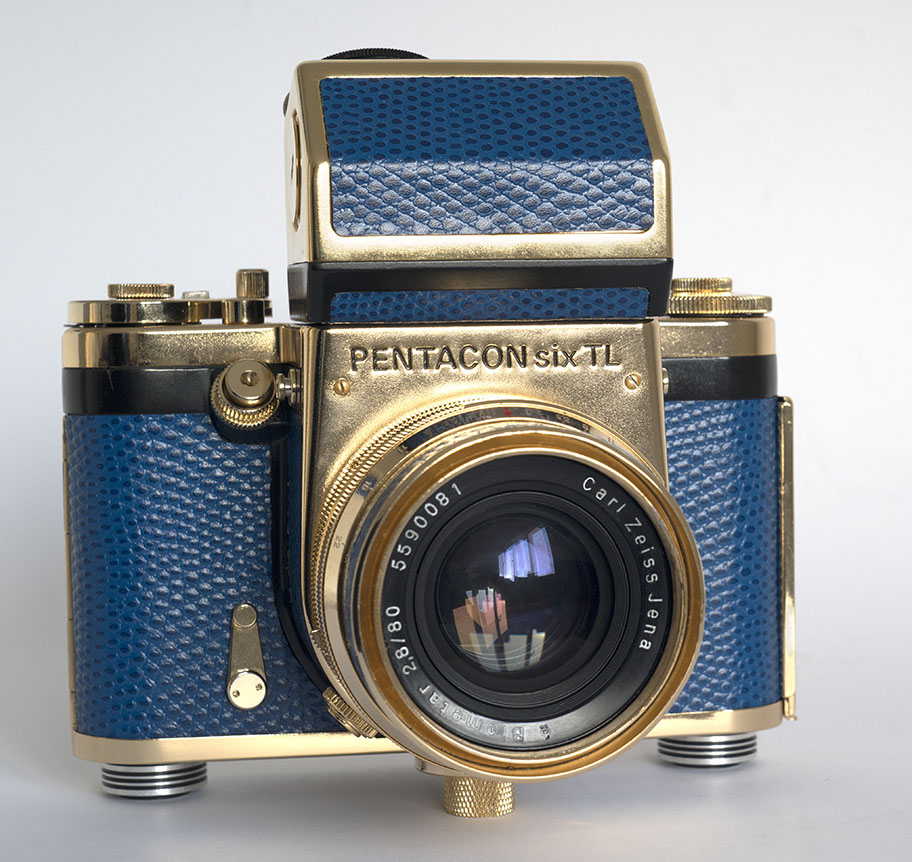 |
|
The Pentacon Six is a high quality
medium format single lens reflex camera taking 120 and
220 film for 12 or 24 exposures that are nominally 6cm x
6cm (2¼ x 2¼ inches) – actually 56mm x 56mm, as is
standard for medium format cameras. A TTL metering
prism (shown on this camera) is available, as well as an
enormous range of lenses and other accessories.
The camera and its predecessor, the Praktisix, was
manufactured in East Germany (the GDR) between the mid
1950s and 1990.
|
For guidance on loading the Pentacon
Six, click here.
To read about using flash with
the Pentacon Six, click here.
The Kiev 60
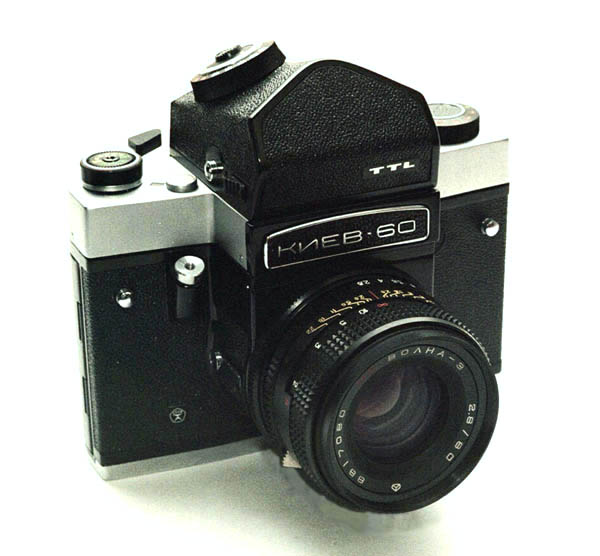 |
|
The Kiev 60 is manufactured by Arsenal
in Kiev, Ukraine. It is broadly modelled on the
German Pentacon Six, and uses the same lens mount.
It is shown here with the TTL metering prism. The
previous Arsenal version of this camera was called the
Kiev 6C. It differs by having the shutter release
on the left-hand side, and by also accepting 220 film
for 24 exposures, as well as 120 film (12
exposures). The Kiev 60 only accepts 120 film. |
The Exakta 66
| The Exakta 66 is a (West) German camera
based on the (East) German Pentacon Six chassis and also
incorporating the optics from the Pentacon prism.
As well as being clad in a tough rubber coating, it
incorporates circuits to transmit the selected shutter
speed to a TTL prism that works at full aperture. |
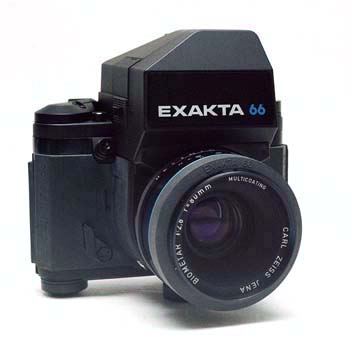
A lug on the aperture ring of lenses from
Joseph Schneider, Bad Kreuznach, transmits the chosen
aperture value to the meter. |
|
|
|
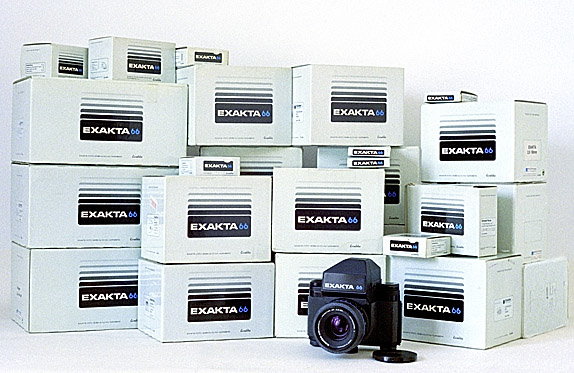
When the Exakta 66 was launched in what
was at that time West Germany, shops carrying it
displayed an impressive range of lenses and other
accessories, in stylishly-designed boxes carrying the
logo of the new camera. |
The camera is not to be confused with
two other cameras (manufactured in the 1930s and early
1950s, respectively) with the name “Exakta 66”.
For instructions on how to use the Exakta 66 metering
prism, see here.
|
The Kiev 88 with
Pentacon Six mount
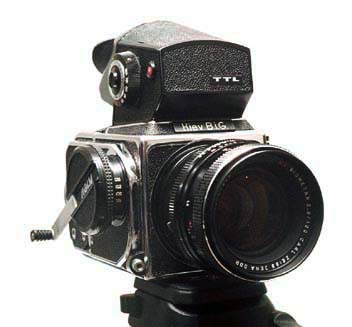 |
|
The Kiev 88 has been available for many
years, and is in fact a newer version of a range of
cameras all inspired, modelled on or copied from the
Hasselblad 1600F and its immediate successor, the
1000F.
The Hasselblad 1600F was launched in October 1948. It
had a stainless steel focal plane shutter with a top
speed of 1/1,600 sec. Problems with this shutter led to
the release of the Hasselblad 1000F (with a maximum
shutter speed of 1/1000 sec) in late 1953.
In 1957 Hasselblad abandoned the production of medium
format cameras with focal plane shutters, and introduced
the 500C, which used lenses with shutters in them.
However, the orginal Hasselblad “clone” (if that is what
it was), produced by the Arsenal factory in Kiev,
Ukraine in 1957 and named the “Salyut” was virtually
identical with the Hasselblad 1600F and had a top speed
marked 1/1500 sec.
Its lens mount was the same as the Hasselblad 1600F
mount, and this is not compatible with the
Pentacon Six.
The Salyut was produced from 1957 to 1972, and was
sometimes marketed, at least in the U.K., with the name
“Zenith-80”. In Germany, it was sold by
Foto-Quelle with their brand name, “Revue 6×6” or
“Review 80”.
In 1972 this camera became the Salyut-S, with a maximum
shutter speed of 1/1000 sec. The Salyut-S was
apparently available until 1980, although from 1975
onwards some of these cameras were produced with the
name Kiev-80. From 1980 onwards, the camera was
called the Kiev-88. However, all these cameras had
the original Hasselblad 1600F type lens mount, and
therefore do not interest us if we are looking for a
camera that can use our Pentacon-Six mount lenses. |
For more information on the Hasselblad
cameras, I recommend: “The Hasselblad Compendium” by
Richard Nordin, published by Hove Books. ISBN
1-897802-10-2
For more information on Salyut, Kiev and other “Soviet”
cameras, I recommend: “Made in USSR The Authentic Guide
to Russian and Soviet Cameras, Second Edition” by Jean
Loup Princelle, published by LE REVE EDITION ISBN
2-9522521-1-4 |
The Kiev 88 begins to be of interest to us from
about 1994, when some of these cameras were modified by changing
the lens mount to accept Pentacon-Six mount lenses. As the
distance from the front of the camera to the film plane is
greater on the Hasselblad and the Kiev 88 than on the
Pentacon-Six, this mount had to be recessed within the front of
the body, and some of the early modifications did not accept all
Pentacon-Six mount lenses. For limitations on the
compatibility of this modified mount, see Compatibility Issues.
The first Kiev 88 with Pentacon Six mount to be
readily available in the West was marketed in Germany by Brenner
Fotoversand,. The camera pictured above was supplied by
them, and has also been fitted with a wind crank by
KievUSA. In this picture the Carl Zeiss Jena 120mm
Biometar is mounted on the camera.
The viewfinder mounting on the Kiev 88 is
compatible with the Hasselblad viewfinder mounting, which allows
inter-changeability of waist level finders and prisms.
Although the Hasselblad and Kiev film magazines look virtually
identical, they are slightly different and cannot be swapped
between the two brands of camera. However, there are also
versions of the Kiev 88 that have been modified either by the
manufacturers or by others to make the film magazine compatible
with Hasselblad. A good source for this in the past has
been Mike Fourman at Kiev Camera, but his website is no longer
running at the present time (March 2007), so I suggest that you
contact some of the other vendors listed on my Links
page.
For a review of the Kiev 88-6 from Brenner shown
above, click here.
Hasselblad
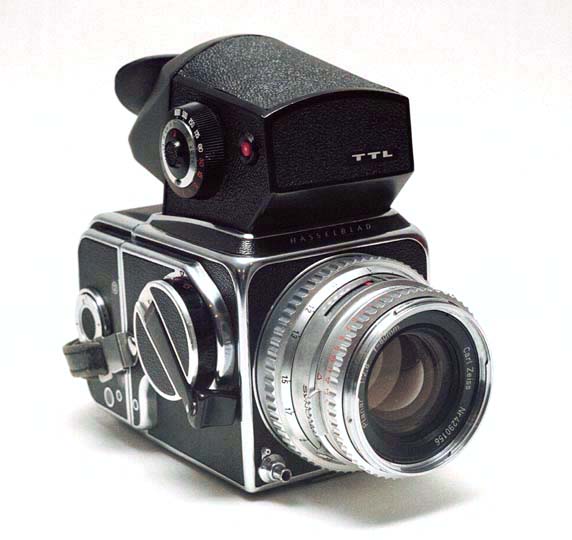 |
|
Not compatible with the Pentacon Six,
but for comparison purposes, here is a Hasselblad 500C
with the standard Carl Zeiss Oberkochen 80mm Planar
mounted on the camera. This camera is here fitted
with an Arsenal metering prism designed for the Kiev
88.
For the lens tests section of this
website, comparison shots were taken with this camera
and some Carl Zeiss Oberkochen lenses.
|
What do they weigh?
Here are the weights of the three
main cameras referred to on this website, with the details of
the Norita and the Hasselblad 500C added for comparison
purposes:
| All cameras except Hasselblad with
metering prism, standard lens with filter & cap,
take-up spool but no film or case |
Metric Weight in grams (g) |
Weight in pounds (lb) and ounces (oz) |
| Pentacon Six TL |
1,710 g |
3 lb 12 1/4 oz |
Kiev 60
(including flash bracket with hot shoe adapter, and
strap) |
2,025 g |
4 lb 7 3/8 oz |
| Exakta 66 (with Xenotar MF lens, cradle,
strap & locking nut) |
2,015 g |
4 lb 7 oz |
| Norita 66 |
1,960 g |
4 lb 5 oz |
| Hasselblad 500C with standard Planar
lens with cap but no filter, 120 back with take-up spool
and dark slide, Maxwell screen and meter prism 52051, no
strap |
1,830 g |
4 lb ½ oz |
Note that the Xenotar MF is the only one of these
lenses known to have 7 elements, and the Noritar is the only 6×6
Medium Format standard lens with a maximum aperture of
f/2. An early version of the Planar had 6 elements, a
later version, 7. It is not known which this is, but it
was first sold in 1967 and appears to be an early version.
The later version might be heavier.
Important note: I do not have scientific
scales; all items are weighed on domestic kitchen scales and are
valid for comparison purposes only. The scales give
repeatable weights + approx 5 grams. Weighing
components individually and adding these weights may result in a
cumulative error. I therefore consider that the total
weights given in this chart are the most reliable. Note
that manufacturers’ published weights of lenses, reproduced
elsewhere on this website, will not include filters or caps.
Also remember that most of these cameras and
lenses were produced over many years, and there may have been
changes in internal components and materials used. These
weights apply to the cameras that I have. You may obtain
different weights with different scales, or with different
examples of these items.
And the winner is …
This is easy, with a clear difference from
lightest to heaviest:
|
1) The lightest
|
Pentacon Six TL |
1,710 g |
3 lb 12 1/4 oz |
|
2)
|
Hasselblad 500C |
1,830 g |
4 lb ½ oz |
|
3)
|
Norita 66 |
1,960 g |
4 lb 5 oz |
|
4)
|
Exakta 66 (with Xenotar MF lens, cradle,
strap & locking nut) |
2,015 g |
4 lb 7 oz |
|
5) The heaviest
|
Kiev 60 (including flash bracket
with hot shoe adapter, and strap) |
2,025 g |
4 lb 7 3/8 oz |
Note that the Exakta 66 is the only one of these
cameras offered with a choice of standard lens. It is here
listed with the heaviest of its standard lenses.
Is the Pentacon Six “too big”? See here.
Other Cameras
But why buy the Pentacon Six or Exakta 66?
Why not one of its rivals: other Medium Format SLR cameras in
the 35mm style?
The two most obvious rivals are:
To see a review of these camera systems, click the
name of the camera.
To see Operating Instructions for the
Pentacon Six, click here.
To read “Myths about the Pentacon Six”
click here.
To choose other options, click below.
Home
© TRA January 2002 Latest revision:
September 2021





